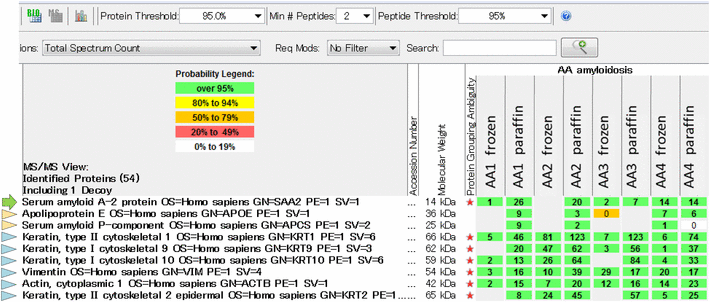

Inflammatory cells and elevation of cytokines in eosinophil-treated mice. (A) The total cell count in BALF was significantly increased in the group receiving instillation of eosinophils compared to control mice (each group, n = 4). (B) Differential cell count showed significantly increased number of macrophages and lymphocytes in eosinophil-instilled mice compared to controls. (C) Mice intratracheally instilled with eosinophils had significantly elevated levels of MCP-1/CCL2 and TGF-β1 in BALF compared to controls. IFN-γ and IL-13 showed no significant change. Data are expressed as means ± SEM.
Inflammation and fibrosis of the airway walls induced by eosinophils instillation in vivo. (A–F) Representative lung sections from control (n = 3; A, C, E) and eosinophil-instilled mice (n = 4; B, D, F). Specimens were stained with Hematoxylin-Eosin (A, B), Masson trichrome (C, D) and immunostained for type I collagen (E, F) and examined by light microscopy.
The software is designed to allow capturing of images with concurrent storage of their captured positions as height information for later use by the software 3D Viewer (optional) to obtain a 3D view of the resultant in-focus merged image. The areas of hepatic fibrosis were subsequently measured in 10 randomly selected fields in each specimen (magnification, ×400; Olympus BX51N-34 microscope; Olympus Corp., Tokyo, Japan) using WinROOF software (version 5.71; Mitani Corporation, Tokyo, Japan).
Mice receiving intra-tracheal eosinophils had increased infiltration of inflammatory cells around the bronchi (B), peribronchial fibrosis (D) and deposition of type I collagen (F) in lung tissue compared to controls (A, C and E). (G, H) Collagen deposition (G) and immunoreactive areas for type I collagen (H) were quantified using WinROOF software. Lung tissue of eosinophil-instilled mice showed significant deposition of collagen as compared to control. The data are expressed as the mean percentage of the total lung field area ± S.E.M. The scale bars indicate 50 µm. Data are expressed as means ± SEM.
Induction of epithelial–mesenchymal transition in the airways by eosinophils in vivo. (A, B) Representative immunofluorescence staining of E-cadherin (green), α-SMA (red) and nuclei (blue) in the airways of mice instilled with saline (A) or eosinophils (B). Cibc eft 80 byte file layout in unix commands. (C, D) Quantification by densitometry disclosed low expression of E-cadherin (C) and increased expression of α-SMA (D) in mice after eosinophil instillation (n = 4) compared to control (n = 3).
The data are expressed as the mean percentage of the total lung field area ± SEM. The scale bars indicate 50 µm. Data are expressed as means ± SEM. Human eosinophils induced EMT morphological changes in BEAS-2B cells. (A, D) control, (B, E) BEAS-2B cells co-cultured with eosinophils. (C, F) BEAS-2B cells cultured in the presence of TGF-β1.
BEAS-2B cells were stained with Diff-Quick after washing out eosinophils (A, B, C). (D, E, F) Immunofluorescence staining was performed with phalloidin (red) and DAPI for nuclei staining (blue) after washing out eosinophils. The scale bars indicate 50 µm. (G, H, I) RNA expression of E-cadherin and vimentin in BEAS-2B cells co-cultured with or without eosinophils and in the presence of TGF-β1 as assessed by RT-PCR and densitometry analysis.
(K, L, M) Protein expression of E-cadherin and αSMA in BEAS-2B cells co-cultured with or without eosinophils as assessed by Western blotting and densitometry analysis. Data are expressed as means ± SEM.
Eosinophils induced secretion of TGF-β1 from BEAS-2B cells. (A) TGF-β1 levels in the supernatant from each cell condition. (B) Representative Western blotting of Smad3 and p-Smad3. (C) The ratio of p-Smad3 to Smad3 analyzed by densitometry. (D, E, F) Morphological changes in each cell condition. (G, H, I, J) Effect of anti-TGF-β1 antibody on the protein level of TGF-β1 and RNA expression of E-cadherin and vimentin during each cell condition. BEAS-2B cells were stained with DIFF-QUICK.
The scale bars indicate 50 µm. Data are expressed as means ± SEM. Relevant role of TGF-β1 in airway remodeling and the need of direct contact of eosinophils for TGF-β1 production. (A, B, C) Mice receiving instillation of eosinophils pre-treated with TGF-β1 siRNA have less peribronchial fibrosis than those receiving eosinophils pre-treated with scrambled RNA as assessed by Masson staining.